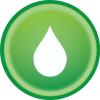Water Efficiency

Be Bucket Smart
Leave a bucket in the shower to fill with "gray water," (water that runs when you are lathering up). You can use this water to wash your car or water your plants (except for plants you intend to eat).
Handwash Carefully
If done properly, washing dishes by hand tends to be more energy-efficient than using a dishwasher, especially for small volumes of dishes. Instead of washing under a running faucet, put a plug in the sink, or use a large, plastic bowl. And to minimize the amount of water used when rinsing, install a low-flow aerator on your kitchen sink faucets. When washing dishes by hand, minimize the number of times you need to change the water by washing the least-dirty items first.
Practice Smart Showering
If you install a low-flow showerhead, it will not reduce your water pressure. You can purchase a low-flow showerhead for as low as $10.
Reduce Rinsing
According to Consumer Reports, pre-rinsing dishes before you put them in the dishwasher wastes up to 20 gallons of water per load, and doesn't get them any cleaner!.
Save on the Flush
Consider installing a water-efficient toilet to save water.
Soaker Hose
Soaker hoses water more efficiently by sending moisture straight into the ground, near plants' roots, rather than into the air, where water is lost to evaporation.
Water Heater Smarts
Your water heater can be a source of wasted energy. By insulating your hot water pipes, you can avoid heat loss when the water is traveling. Additionally, setting a water heater limit – 140 degrees is the maximum needed, even for your dishwasher – can lower water costs. Lastly, before leaving for vacation, remember to unplug large appliances, and don't forget to turn down (or off) your water heater.